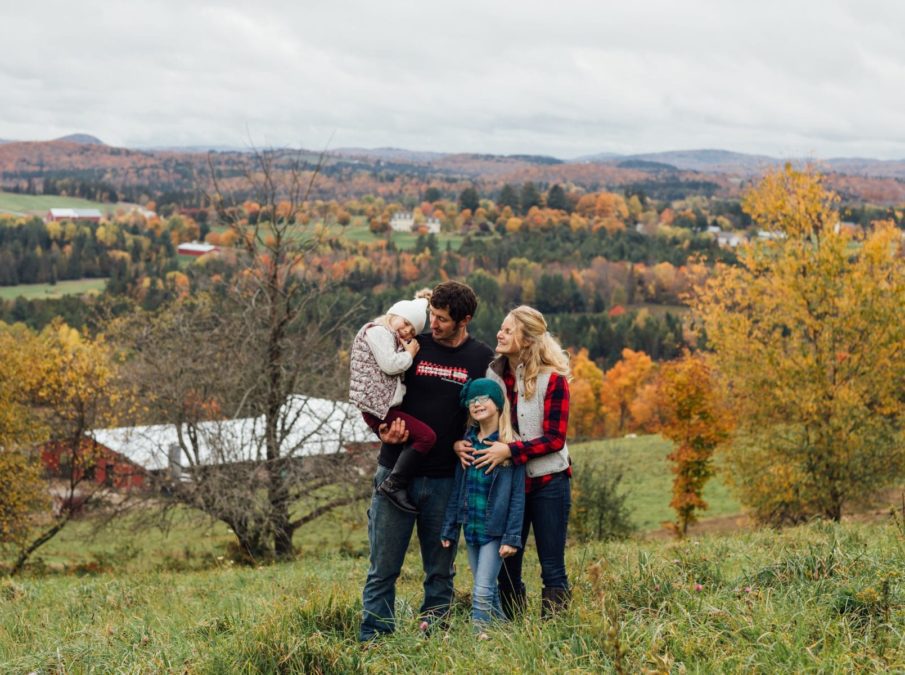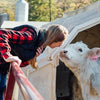
FarmLove – The McDonald Farm
It was 1919 when 94 central Vermont farmers joined forces to turn their surplus milk into butter. Each contributed $5 per cow and one cord of wood to fuel the cooperative venture in a creamery in the small town of Cabot. A century later, the co-op has grown to over 800 farmer-owners and the McDonald Farm in Danville has the distinction of being the sole representative of the original 94.
 Farmer James Beattie—a McDonald on his grandmother’s side—believes his family was either the third or fourth to join the co-op. The farm was settled by his Scottish ancestors in 1839. “My kids make it seven generations on the farm,” he says proudly.
Farmer James Beattie—a McDonald on his grandmother’s side—believes his family was either the third or fourth to join the co-op. The farm was settled by his Scottish ancestors in 1839. “My kids make it seven generations on the farm,” he says proudly.
Growing up, James spent most of his spare time on the farm where his paternal grandmother, Catherine (Kate) McDonald Beattie, had raised her 10 children, along with four from her husband’s first marriage. “She was born and died in the same room of the farmhouse,” James says. Kate was legendary for her hard work, commitment to farming, and her community involvement. “She had one of her kids between chores,” her grandson continues. “She milked that morning, told the hired hand she had to go, went to the hospital, had the baby and came back home that night.”
Kate McDonald Beattie’s 2014 obituary lists many accomplishments and accolades including the Vermont Agricultural Experiment Station’s “Unsung Hero” award, inauguration into the Vermont Agricultural Hall of Fame, and the Vermont Farm Bureau President’s Award for her many years of service to that organization. The family continues her legacy of public service; two of her daughters currently serve in the state legislature, as she did also. 
In addition, “Kate was known for her hospitality,” the obituary reads. “Carrying on the Vermont farm tradition, her home was open to everyone in the community and even those just passing by. No one could leave her kitchen without being given something to eat.” A renowned cook, Kate’s recipes were published in Yankee magazine; she was especially known for her maple pie, also featured by the Food Network. Her grandson recalls that Cabot cottage cheese was a favorite of Kate’s and he inherited a fondness for it. “I can sit and eat a whole container of it straight,” he says with a laugh. 
James notes that both his grandmother and her sister were married in the family house, which dates back to 1874. He and his wife, Lyndsay, are gratified to be able to raise their own two daughters in the historic home. The center downstairs room, where the weddings took place, is still anchored by the original elaborate brass chandelier and an elegant birdseye maple staircase. “My grandmother put in writing that those could never be changed,” James says.
Other things on the farm have changed, of course. The family milked only about three dozen cows when James was growing up; today, the 110 milkers live in a new barn built in 2013, while the young stock are in an older barn that dates back to 1896. “I always hoped to end up on the farm,” James says. “It was fun, a lot of freedom. Helping on the farm felt important. I liked the responsibility; it teaches to you a lot.” 
Although he doesn’t dwell on it, James takes his heritage quite seriously. “Keeping the history going,” he says, “was definitely part of the drive.” Another factor is the satisfaction of watching his girls grow up around the animals and farm like he did, and knowing they appreciate how deep their roots go. “They get it,” James says, “but we don’t push. We’ll let them choose it on their own.”














